Plant of the Week
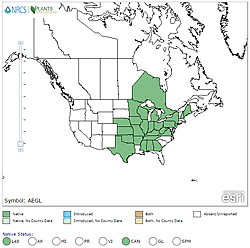 Aesculus glabra range map. USDA PLANTS Database.
Aesculus glabra range map. USDA PLANTS Database.
 Small tree with partial autumn color. Photo by David D. Taylor.
Small tree with partial autumn color. Photo by David D. Taylor.
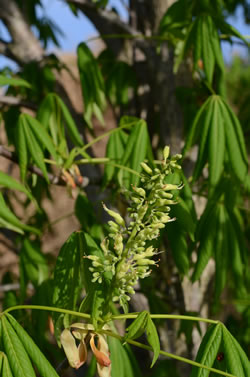 Panicle of flowers. Photo by David D. Taylor.
Panicle of flowers. Photo by David D. Taylor.
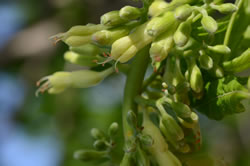 Close up of flower. Photo by David D. Taylor.
Close up of flower. Photo by David D. Taylor.
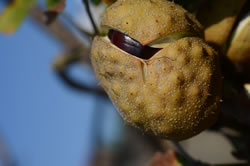 Close up of capsule showing bumps and spines. Photo by David D. Taylor.
Close up of capsule showing bumps and spines. Photo by David D. Taylor.
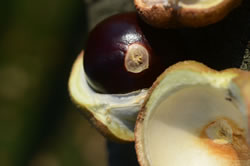 Close up of seed and inside of capsule. Photo by David D. Taylor.
Close up of seed and inside of capsule. Photo by David D. Taylor.
Ohio Buckeye (Aesculus glabra Willd.)
By David Taylor
Ohio buckeye is a member of the Hippocastenaceae, the Horse Chestnut family. Species in this family range from medium shrubs to large trees. Well known species include various buckeyes and horse chestnut (A. hippocastanum), an ornamental widely planted in the northeast and northwest.
This tree reaches 21 meters (about 70 feet) tall, occasionally taller. The stem may reach 60 centimeters (2 feet) diameter. Leaves are opposite and palmately (arranged like fingers on a hand) compound with five (rarely 6 to 8) leaflets. Each leaflet is toothed and 7 to 15 centimeters (2.75 to 5.9 inches) long by 4 to 5 centimeters (1.6 to 2 inches) wide. The leaves are light to medium green above and light green below. Flowers are borne in terminal clusters (panicles) 10 to 15 centimeters long (3.9 to 5.9 inches), sometimes longer. The panicles are about two-thirds as wide as long. Flowers are greenish-yellow and about 2 to 3 centimeters (0.75 to 1.2 inches) long. Each flower has four pale yellow to greenish petals. The stamens stick out of the flower. Fruits are 3 to 5 centimeters (1.2 to 2 inches) diameter, bumpy capsules with soft (hard when young) spines. The capsules split open releasing 2 to 4 brown seeds, each with a lighter area.
Ohio buckeye is a bottomland species usually found on moist soils on floodplains. It also occurs on drier, more upland sites. It is occasionally found along roadsides and in fencerows. It is found from Minnesota, south to Iowa and Nebraska, and south to Texas, east to Georgia (but not Louisiana), north to Tennessee, Kentucky and West Virginia, then north to New York. It is also known in New Hampshire and Maine, Missouri and Illinois. It is also known from Ontario, Canada.
This species flowers in April to May depending on the part of the country in which it is found. The tree is sometimes planted as an ornamental. Some wildlife species eat the seeds, but raw they are poisonous to humans and most domestic livestock. A variety of native bees visits the flowers, but the pollen and nectar are poisonous to honeybees. In some recent taxonomic treatments, the Hippocastenaceae is put into the family Sapindaceae.

